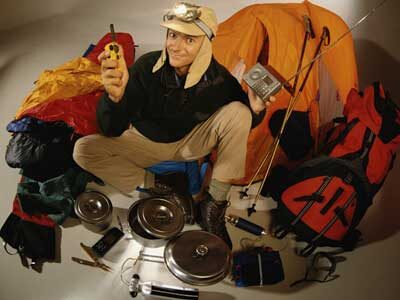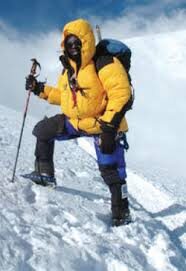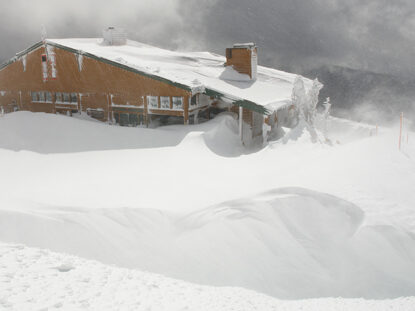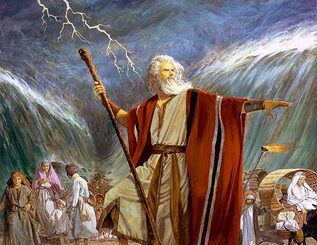
Basic Gear To Buy And Bring
You really don’t need all the stuff this backpacking guy has but there is some basic gear that day hikers like the Ramblers should have. This list is NOT complete and you’ll learn through experience on the trails what you need and what you don’t need but this should help you get started.
Basic Gear – Backpack:
- Buy a good backpack from a reputable manufacturer. Ask other hikers what they use and why. Also ask what they like about their packs and what other features they wish they’d have on their packs.
- Weight is always a consideration but if you buy a pack that’s too small for your gear then you’ll have to hit the trail without something you want or need and you’ve wasted $100+ on the pack. Most hikers use a pack that’s at least 24 liters in volume but many like a bigger pack. And remember, you’ll be carrying more gear in the winter than in the summer so select a size that will accommodate all your extra winter stuff.
- Many manufacturers have packs designed specifically for a woman’s torso. If you’re a lady hiker one of these might make your hike that much more comfortable.
- Make sure your pack will store an internal water reservoir. Even if you don’t use it early on you might change your mind after playing the Water Bottle Shuffle after a few hikes. Most packs will handle a 3-liter reservoir.
- If the pack you select doesn’t come with a rain cover, buy one. We hike where it can rain at any time and if all your gear gets wet you won’t be happy.
Basic Gear – Boots:
- The most expensive boot is not necessarily a good boot for you. If it fits and is comfortable…it’s a good boot. If it doesn’t fit and is not comfortable, you’ve wasted your money and are guaranteed to have a lousy hike. Ask other hikers what brand and model they like and why. For your first pair don’t try to buy online. Go to a sporting goods store that has a wide selection of boots and get fitted properly. And when you go make sure you take a pair of hiking socks (and liners if you use them). If you get fitted for boots in street socks the boot will be too small.
- Like backpacks there are manufacturers and models of boots specifically designed for a woman’s foot. Lady hikers should consider this and this is another reason to buy your first pair of boots from a sporting goods store with knowledgeable people who can get you a proper fit.
- Pony up the extra $$$ for a waterproof boot. You won’t regret it. Where the Ramblers hike it rains and there are times when we have to walk through water. If your boots get soaked, your socks get soaked. If your socks get soaked, you’ll get blisters. There’s no faster way to have a horrible hike than to get blisters on your feet.
Basic Gear – Hiking Poles (Sticks)
- As we get older these become more and more appreciated. They will help you climb but also make descents a lot easier on your hips, knees and feet. They can also help you control your speed during a descent so you don’t lose control and take a tumble.
- The lighter the weight the better but like bicycles the lighter the weight the higher the cost. Consider this, you won’t be buying new poles every week. Once you get a good pair they should last you a lifetime.
- Make sure they’re adjustable based on your height. You’ll want to shorten them going uphill and lengthen them going down. There are poles that adjust length using a “screw lock” mechanism and poles that use a “pullover lock” mechanism. Try them both.
- Make sure your poles will accommodate different cups at the bottom. You’ll use a small cup for most hikes but a large one when in the snow. The cup keeps the tip of the pole from penetrating too far into the ground.
Basic Gear – Inside The Backpack:
- Carry plenty of water. Even if you have some left over after the hike you can spill it out. It’s biodegradable. You don’t want to run out of water. On a short hike consider at least 1 liter of water. For longer hikes, take 2 liters. The Ramblers do some strenuous hikes in the summer where 3 liters is a must. Bring your water in an internal reservoir or a couple of bottles, BUT BRING PLENTY OF WATER.
- Bring a lunch. You’ll figure out how much food to bring and what packs well, but the Ramblers stay out for the day and lunch is something we do along the trail.
- Bring snacks like granola bars or trail mix. Sometimes the blood sugar gets a little low before or after lunch and taking a short break with a snack and a long drink of water is all that’s necessary to get you back up to speed.
- You’ll need a rain jacket. Get one that’s lightweight and has a hood. This should be a permanent item in your pack even on sunny days. We get warm during a hike but at lunch when we’re not moving it can get chilly. Slipping on the rain jacket will keep you comfortable. Rain pants are good too but you won’t need them on every hike.
- Consider carrying a rain hat with a wide brim. Rain jackets have hoods but water can still get on your face. And if you wear glasses rain on your face means you’ll have a hard time seeing where you’re going. A rain hat does a better job keeping the rain off your face and off your glasses. And remember, the rain hat doubles as a sun hat on sunny days.
- Pack a knit cap, gloves (mittens) and other cold weather clothes as the weather dictates.
- It’s always wise to carry a small first aid kit. Your kit should include ibuprofen (or other anti inflammatory), alcohol wipes, sterile bandages and a blister kit.
- Not necessary but nice is something to sit on during lunch. A pad of some sort will not only make the lunch spot more comfortable but keep you warm and dry. Hiking back to the cars after lunch with a wet tush isn’t much fun.
- Some hikers like to carry an extra pair of socks in case they manage to get into water above the top of their boots which leads to wet socks and blisters. If this happens you can change into a dry pair of socks.
-
One thing we also recommend is an Emergency Medical Form (LINK). Please take a look and consider filling one out and keeping it in your pack.This information is confidential and will only be used if you are injured or have a medical emergency on the trail and cannot communicate with us. Also rescuers would need access to this information to help you.
- Last but certainly not least… BRING SOME BIODEGRADEABLE TOILET PAPER. ‘Nuff said.
Basic Gear – The Ten Essentials
- The Ten Essentials is a list of items that every backpacker should have on a backpacking trip. Some of the items apply to day hiking like the Ramblers do and some don’t. Why not take a few minutes to read the list?
- Here is a link to the Washington Trails Association website that discusses The Ten Essentials. CLICK HERE to read about The Ten Essentials.

Hiking In The Cold
For new hikers or hikers having recently moved to the North Olympic Peninsula from warmer climes, the Monday Ramblers Steering Committee would like to offer some advice on to how to deal with cold weather. It's not that the weather here is terrible, but knowing how to prepare for temps below the 40s will make your hiking experiences more enjoyable as well as safer.
Perhaps the most important idea of all is the mantra, "Don't Sweat It!" This has two obvious meanings. First of all, don't let the little stuff of life get you down. There are important issues attending to hiking and the not so important ones. Concern yourself with the important stuff and let the minor things slide off your back. But then, in a literal sense...don't perspire. The trick to keeping warm and avoiding hypothermia is to stay dry. Wet clothes are not just uncomfortable in cold weather they can be dangerous. So what's the cold weather trick to staying dry and warm in the cold? Wear layers and wear the right layers.
By wearing layers you can put on or take off whatever you need to to stay dry and warm. Several light layers are much better than one heavy layer. And although this won't sit well with some hikers the use of man-made fibers in garments is much better than natural fibers such as wool. Here's why:
- Man-made fibers wick better than natural fibers. Wicking is the process of pulling moisture away from the skin to keep you dry. Yes, wool has excellent wicking capabilities but man-made fibers wick better.
- Man-made fibers will keep you warm even if they become completely sodden. This is not the case with natural fibers. Once wool or down get wet they can no long insulate you from the cold. Man-made fibers keep their insulation capabilities even when completely soaked.
- For the same level of warmth (think about the R value in your house's insulation) man-made fibers weigh less than natural fibers. You'll be carrying extra gear in your backpack in the cold weather so why carry even more on you?
- Man-made fibers are easier to maintain. They can be thrown in a washing machine and dryer as long as you use the appropriate cycles. Try machine washing and drying a wool shirt. Hand washing and drying isn't convenient.
Pat Gritman has hiked in some really cold weather on the east coast and she offers the following list of things to put in your backpack for winter hiking:
- microspikes or "Yak-Tracks" for snowy or icy terrain
- gaiters for keeping snow out of your boots
- a balaclava for head/face covering
- warm gloves or mittens
- chemical hand warmer packets
- a padded "sit upon" to keep your tush warm and dry during the lunch stop
- a thermos of hot something for lunch---soup is good but so is coffee or tea
- carry plenty of water and stay hydrated by drinking it
Jim Stoffer has offered the following cold weather suggestions:
- opt for mittens rather than gloves as mittens will keep your hands warmer
- carry plenty of water and drink it as staying hydrated will help avoid hypothermia
If you have any other cold weather hiking tips and tricks to share with our warm weather friends, please contact the webmaster and your contributions can be added to the list above.

Hurricane Ridge Weather Links
Hurricane Ridge Webcam
Hurricane Ridge Current Conditions And Forecast
Hurricane Ridge Current Snowfall And Previous 24 Hours

Hike Leader Responsibilities
If you're interested in leading a hike for the Monday Ramblers here are your responsibilities with safety the upmost importance:
- Any scheduled hike that you sign up to lead and then find the weather or conditions are not favorable, you as the leader can decide to change the hike location. Or depending on conditions, or if it's a "Leader's Choice", you may need to select a different start time other than the normal 8:30am.
- The Monday Ramblers limit each hike to 12 hikers; however, we occasionally have waitlists of 1-4 people. We know each hike is different and as a Hike Leader, you may feel comfortable taking a few more people, so we are giving each Hike Leader the discretion to take up to 16 hikers. The 12-hiker rule is done to comply with regulations in Olympic National Park and the Wilderness of Olympic National Forest as well as being able to keep the hiking group manageable.
- Once the hike is announced via the Ramblergram email, hikers are instructed to email you to request being included and must provide their phone number, email address, and their emergency contact person and their phone number. Enter this information into the signup sheet (found on the 'Hike Schedule & Descriptions' page of this website). This sign-up sheet should be carried by the Hike Leader until leaving the trailhead at the end of the hike and heading home.
Each Hike Leader should send an email to the hikers on their list on either Saturday or Sunday before the hike with any pertinent information about the hike or meet up location. If someone needs to cancel and forgot they signed up it is a reminder to them. Also, contact any hikers on the wait list as openings arise.
- On the day of the hike at the meet up location, assign hikers to cars leaving room for any hikers being picked up along the route to the trailhead.
- At the trailhead, gather everyone together for introductions and any last-minute instructions or questions.
- Recruit a volunteer to be the lead hiker (the person out front, if not you) and another volunteer to sweep (the person in the back, if not you). The lead hiker should be familiar with the trail in case the route has to be marked at 'Ys' and junctions. We encourage everyone to carry a two-way radio and be familiar with how to operate it, but make sure the lead hiker and sweep have radios, the radios are turned on and are on the same frequency. Also, the sweep hiker and then the lead hiker on the return trip should have keys for one vehicle in case hikers need to get out of the elements when they return to the vehicles. This is very important during the winter months.
- The hike leader must stay on the "official route" unless some unforeseen circumstance dictates a deviation. If a deviation is necessary, the hike leader will contact the sweep via radio about the change and make sure all the hikers know about the change.
- At the end of the hike and before the cars leave the trailhead, the Hike Leader will count heads to make sure everyone is off the trail and in a car to go home. Leave no hiker behind!
- After the hike, please email a member of the Monday Ramblers Steering Committee if there are any injuries, concerns that need to be addressed or other items you determine to be noteworthy. With two hikes a week there is not necessarily a Streeting Committee member on each hike.
That's about it. If you have any questions about leading a hike, please contact anyone on the Steering Committee. Their names and email addresses are on the CONTACT US page of this website.

Online Trail Resources
The following are links to online resources that will help you understand trails the Monday Ramblers like to use. You'll find distances and elevations as well as some excellent maps. AllTrails is a commercial site that will give you access to National Geographic maps but to use this site to its fullest requires a yearly subscription. The Washington Trails Association site is free but a yearly membership to support the site and the organization is requested so if you use this site on a regular basis please join the organization.
AllTrails (Some Features Require A Subscription)
Rambler Wannabees
